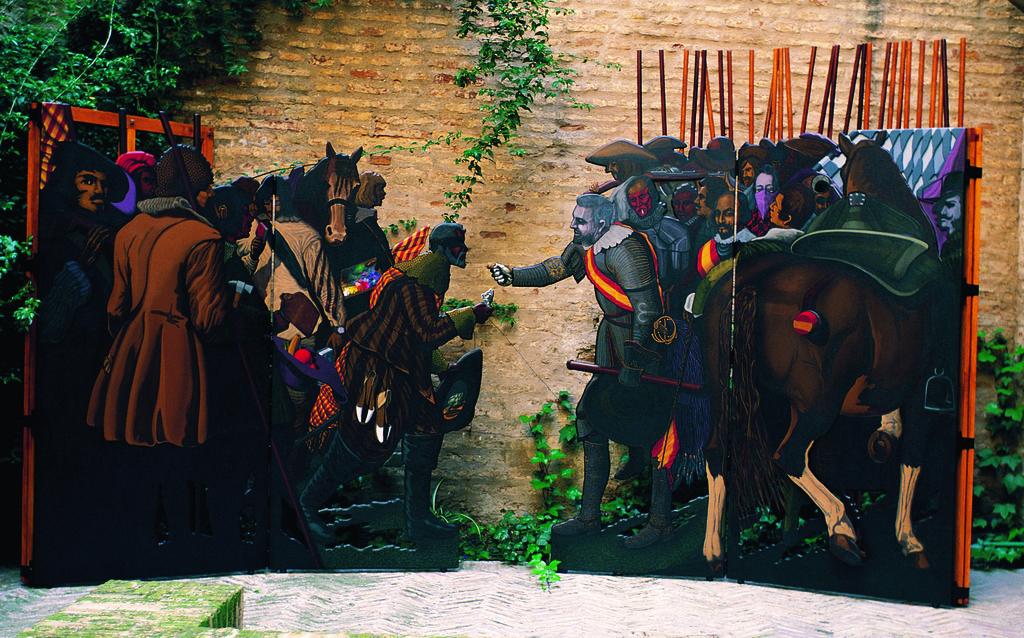Llances imperials (Imperial lances)
While still busy with “The Dollar” series, Antoni Miró made, in the beginning of the Spanish Transition, this work as a vindication of a nationalist and anti-domination nature. All of the artist’s reflections in the late 1960s and most of the 1970s focused on the world’s ills under Yankee Imperialism. Now his attention shifts to problems closer to home and that have a strong bearing on his ideological stance, namely his defence of Catalan culture and national identity. To some extent, this work’s recurrent references to High Culture foreshadow the “Pinteu Pintura” (Paint Painting) series, one that would come to dominate Miró’s output during the next decade.
Yet the work is not a painting as such but rather a revision that turns what is part of the canon of classical paintings into an object. Miró’s appreciation of Velázquez is combined with his rejection of the subject matter he addressed, a Spanish victory during the Flanders war. The defence of the conquered who long for independence and a criticism of the act of domination are the key aspects of this work. His version is a denunciation that uses irony to alter both the general and particular context of the original.
Miró changes the work from a purely pictorial one to a mixed discipline one that combines painting and sculpture. Although it works in hyper-realistic terms, it is not faithful to either a real-life event or any other imaginable real scene. Again, Miró uses the printing techniques used at the time, with flat-inked areas and building volumes through the use of discontinuous blotches of colour using shade gradients. Above all, the meaning of the work is transformed, and so are the nature and the determining factors of the protagonist factions.
The 17th Century oil painting is deconstructed and then rebuilt to create a new scenario. The unity of the original canvas is turned into a duality: there are two differentiated object paintings, one on each side. The still-smoking city of post-siege Breda has vanished from the background. The scene focuses on the political act, transforming the surrender pact into a continuation of the unequal and unfair contract to which the painter constantly alludes in his consideration of the relationship between Spain and Catalonia, the Valencian Country and the Balearic Islands. This course of events, which began with the defeat of Almansa in 1707, has shaped the origin of the relational frame of the next three centuries. It is therefore little wonder that, in this and many other of his works, this date appears in elements containing derogatory connotations in their sign system, for example, a dollar bill in this particular case.
The flat canvas becomes a sculptural volume given that the frames supporting the fabric extend beyond the painted wooden panel. These frames are hinged to create a free-standing element. In addition, the board support is modelled, with pierced gaps, sharpening its edges and creating misalignments, such as the horse’s paw, which sticks out, strengthening the corporal presence of the figures beyond the use of pictorial resources.
Other elements in the composition help give this painting a three-dimensional effect: the spears (bars without spearheads, now all the same length), the circular mirror, creating the kind of cross-views that Velázquez first tried out in Las meninas, and the aluminium closed fist. This metaphor of the concept of iron fist is laid in the centre with an essential condition. The gesture of the Spanish side is a threatening, authoritative one, replacing that in Velázquez’s work in which Ambrosio Spinola condescendingly lays his hand on Justinus van Nassau’s shoulder while he delivers the keys to the city after its surrender. Furthermore, the losers’ leader appears blindfolded, bartering away his people by using the aforementioned dollar bill as a symbol. It is a harbinger of the new conception of the State that is to come.
It is not just the flags that identify the two sides. There are various things linking the losing side, who are not soldiers, with the Valencian culture — fruit and vegetables and a pair of espadrilles, referring to the historical importance of the primary sector in the region. There is also a hammer and a sickle — a nod to agricultural and industrial workers. An allusion to Valencia’s cultural sector can be seen in a painter’s palette, and a committed intellectual wearing glasses and brandishing Mao Tse-Tung’s Little Red Book and Fuster’s Nosaltres els valencians [We, The Valencians], which had been published fifteen years before Miró’s work.
Llances Imperials is undoubtedly a key work in Antoni Miró’s oeuvre and it is one that has had a major symbolic impact on many Valencian intellectuals — something that V. Andrés Estellés freely acknowledges. The work was admirably summed up by Giralt-Miracle after its exhibition in Barcelona: “On the one hand there are the life-sized arrogant victors, who are decked with Imperial Spanish flags. On the other hand, there are the vanquished, with bowed heads, bearing the four red bars. Instead of handing over the keys to the city, the head of the defeated army makes an onerous tribute (a dollar)”.
Santiago Pastor Vila
